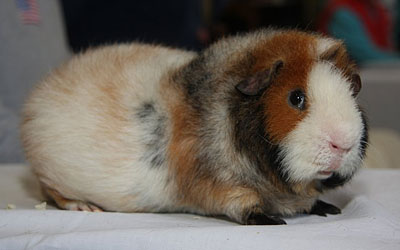
A brief guide to showing guinea pigs (cavies)
At a cavy show, you will find that fanciers - people who breed and show guinea pigs - sometimes call their animals ‘cavies’, and sometimes ‘pigs’, the terms being used interchangeably. The guinea pigs being shown are divided into two main groups.
The first is the Purebred section, for guinea pigs which are of a recognised breed, like Abyssinians for example, with their harsh coat arranged into rosettes. Another purebred is the Dalmation, a smooth short-coated white guinea pig with coloured spots all over its body, usually in black or chocolate colour. You will also see the longhaired varieties with their long coats brushed out onto the boards they are shown on. There are also the ‘Self’ purebreeds, where the pig is smooth coated, and the same colour all over. There are ten recognised colours for the pigs in this group. You can find out more about the various varieties of cavy by visiting the breed club pages on the main British Cavy Council web site. This page lists all the recognised breeds, and will enable you to quickly locate the breed club that caters for them. By following the links, you will be able to find galleries of photos and further links to club web sites, etc.
The second section is for Pets. Some of these are guinea pigs of no particular breed, just ordinary crossbred pet pigs. The judge is not looking for a particular colour or coat type - these don’t matter in pets - so they can be any variety or mixture. Rather, the cavy is judged on its condition and cleanliness and friendliness. You can also show pigs of a known breed in Pet classes. These are usually the ones which are not quite up to the show standard. So a pet guinea pig can be any colour or combination of colours, and can be long, short or rough coated. Showing pets is a good way to start in the fancy, and to learn how to present pigs in show condition.
For a pet guinea pig to be successful in the Pet Classes, there are three things to remember.
(1) The guinea pig must be bathed to ensure it is really clean, and this includes coat, grease spot, ears, feet and nails. Nails must be trimmed if necessary. The coat should be brushed to remove loose hair. Coat to be free from knots or tangles. Longhairs are usually shown with coats clipped to a length that clears the floor.
(2) The guinea pig must be in good health and sound physical condition, and be free from disease. They should be fit not fat, with a well fleshed, muscled body, healthy shining coat and bright eyes.
(3) The guinea pig must also be used to being handled, so should be tame, friendly and calm on the judging table. Allowances are made for younger pigs to be more skittish, as they are not expected to be as steady as adult pigs which have had more show experience.
Purebred cavies must be prepared in a similar way, but each breed has a written Standard to which they are judged. These standards are published as a booklet or can be see on the British Cavy Council website.
Juvenile exhibitors (between the ages of 7 and 16) can obviously enter purebred pigs in the Juvenile purebred section, but can also enter in the ‘Open’ classes, where they are competing against adult fanciers.